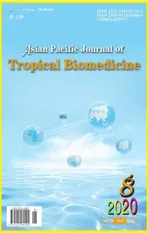Vector-borne diseases: Mosquito holobiont and novel methods for vector control
2020-12-26UpasanaShyamsunderSinghAparupDas
Upasana Shyamsunder Singh, Aparup Das
1Department of Earth and Environmental Sciences, School of Natural Sciences, University of Manchester, England, United Kingdom
2Division of Vector-Borne Diseases, ICMR - National Institute of Research in Tribal Health, Jabalpur - 482003, India
Female mosquitoes of several species require blood from warmblooded animals, including humans for the purpose of reproduction.In this process, several microbes residing in the salivary gland and midgut of mosquitoes also get transferred from one human individual to the other - a traditional model by which many vector-borne diseases (VBDs) get transmitted in the population through mosquitoes belonging to Anopheles, Aedes, Culex and other genera.Considering that VBDs are highly dependent on eco-climatic conditions of a particular location, the net holobiont (mosquito and its community of associated microorganisms)[1] of these medically-important mosquitoes possibly forms an “evolutionarily adapted microbial ecosystem”.Such an adapted microbial ecosystem in the mosquito's salivary gland and midgut has been shown to be not only essential in their development and survival[2], but also can alter vector competence (ability to transmit pathogens in population) of mosquitoes[3].This otherwise means that disruption of such a tripartite interaction (mosquito-microflorapathogens) in an adapted holobiont complex might lead to changes in fitness, vectorial capacity, etc.of the mosquitoes, and pathogenic characteristics of different microbes (opportunists can turn pathogenic).In the tropical and subtropical regions of the globe, VBDs like malaria,dengue, chikungunya, Zika, etc.constitute one of the primary human health hazards and death.Controlling mosquito population (vector control) is considered as one of the finest ways to control VBDs.While traditional vector control strategies have several limitations, novel vector control approaches, viz., (i) reducing vector populations, and(ii) development and usage of mosquitoes refractory to pathogens of VBDs have shown great promises[4].To this extent, recent advent of techniques for transforming mosquitoes refractory to pathogens (e.g.para-transgenesis, gene silencing, gene editing by CRISPR-Cas9, etc.)coupled with a gene drive[5] have been widely discussed and in some cases, vividly used for control of Anopheles and Aedes mosquitoes.
Amongst several approaches, turning mosquitoes that are vectors to different human microbial pathogens into refractory types has gained large momentum.For this, experiments involving two types of symbiotic Gram-negative bacteria that populate mosquito midgut(Wolbachia and Serratia) have yielded several interesting (and somehow contrasting) results.While Wolbachia can help inhibiting malaria parasite, Plasmodium infection in both Anopheles (Anopheles gambie and Anopheles stephensi[6,7]) and Aedes (Aedes aegypti[8])mosquitoes, evidences have been presented that Wolbachia can also enhance Plasmodium infection in Anopheles (Anopheles gambie[9])and Aedes (Aedes fluviatilis[10]) in some cases[11].Similarly, Serratia odorifera in one hand inhibits the development of Plasmodium but on the other hand enhances susceptibility of Aedes aegypti to dengue virus[12].It seems therefore that in different holobiont complex, two different microbial pathogens (Wolbachia and Serratia) behave very differently in term of controlling either Plasmodium or dengue virus.Very similarly, mosquitoes also differ in transmitting different human microbial pathogens in different eco-climatic settings that possibly influence the composition of the holobiont.For example, the Japanese encephalitis virus is commonly transmitted by Culex mosquitoes in almost all the endemic settings but in Malaysia and India, in addition to Culex, Japanese encephalitis virus is transmitted by Aedes butleri[13]and Anopheles subpictus[14], respectively.Furthermore, Anopheles has also been shown to transmit an alphavirus, o'nyong-nyong[15].All these results suggest the fact that mosquito holobionts form adaptive complexes that differ with mosquito species and eco-climatic conditions prevalent at the habitation of mosquitoes.
In mosquitoes, the CRISPR-Cas9 technique has been initiated relatively recently to disable infection to human pathogens, thereby preventing transmission of vector-borne diseases.For example, by knocking-out of the FREP1 (fibrinogen-related protein) gene, which is an essential factor of mosquito innate immune system required for maintaining immune-homeostasis (and thereby keeping the adapted mid-gut floral complex in harmony) in the malaria vector Anopheles gambiae by CRISPR-Cas9 method could help suppress the growth of Plasmodium[16].Therefore, in a situation where Anopheles gambiae mosquitoes are FREP1-deleted, due to altered immune homeostasis and disruption of adapted holobiont complex, existing opportunistic microbes in mosquito midgut/salivary gland might turn into pathogenic form for human and pose new threat to human health.It is therefore essential to develop novel vector control strategies for development of refractory mosquitoes to a particular pathogen with due care not to disrupt the adapted holobiont complex.This is necessary for maintaining homeostasis in mosquito midgut and/or salivary gland for better use of the technique in public health.A holistic view including surveillance on the composition of midgut and salivary gland microflora of the mosquito, geographic structure, in-depth analysis of eco-system surrounding mosquito habitation, reservoirs of the disease pathogen and bionomics of the mosquitoes should be taken into consideration before employing refractory mosquito techniques of vector control to improve public health.
Conflict of interest statement
We declare that there is no conflict of interest.
Authors' contributions
USS conceived the idea, retrieved and analysed the data from publications and wrote the first draft of the manuscript.AD made necessary critical revisions for important intellectual content and wrote the final draft of the manuscript.
杂志排行
Asian Pacific Journal of Tropical Biomedicine的其它文章
- Gymnema montanum improves endothelial function via inhibition of endoplasmic reticulum stress by activating Nrf2 signaling
- Peanut testa extracts enhance anticancer effect of cisplatin against human cholangiocarcinoma cells via modulation of histone deacetylase inhibitory activity
- Immunosuppressive and antibacterial activities of dihydromorin and norartocarpetin isolated from Artocarpus heterophyllus heartwoods
- Metabolite profiling and antidiabetic attributes of ultrasonicated leaf extracts of Conocarpus lancifolius
- Isolation and characterization of five novel mini-Mconotoxins from the venom of mollusk-hunter snail Conus bandanus
